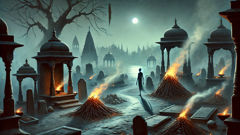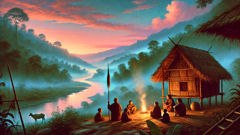Introduction
Beneath the low, honeyed light of dusk in the subcontinent, stories would gather like dust motes in a monastery courtyard—restless, stubborn, and warm with memory. People named them rakshasas: beings who moved between shape and shadow, whose laughter could sound like a drumbeat across a river, whose footsteps might echo in a palace hall or beneath a banyan tree. To the villagers, a rakshasa was the reason a child dared not wander the fields after dark; to the rishi and the king, it was a test. Their mythic presence threaded through early epics and roadside tales alike, never a single image but a shifting portrait—sometimes monstrous, sometimes oddly regal; sometimes animal, sometimes peasant, sometimes thunder-robed warriors descending from clouds. They were fighters of fierce appetite and cunning, illusionists whose most dangerous weapon was not the mace or the fang but the ability to make the world tremble with doubt: Was that riverbank a safe crossing, or an illusion that would open into teeth? Was the friend at the next table a friend, or a mask? The rakshasas, then, were not merely creatures of malice. They were the personification of unruly impulses in a universe that prized order—embodiments of hunger, ambition, grief, and the seductive promise of power without restraint. This story traces their contours: origin whispers in the fires of creation; the ways they learned to borrow forms and thoughts; the lines where courage and cruelty blur; the encounters with sages who sought to purify and with kings whose pride invited ruin; and, finally, the quieter reckonings where some rakshasas changed shape not only outwardly but inwardly, discovering a strange need for balance and a path toward stories that held both caution and compassion. In these pages, you will find cratered battlefields and mist-laced temples, mothers and monsters, riddles that test the heart, and an old world where truth often wore many faces. The aim is not to fix the rakshasa in one box of explanation, but to let the old voices breathe: to hear why people in the shadow of riverbanks prayed for light, why poets compared ambition to a rakshasa’s hunger, and why, in the end, myths about fearsome beings often point back at human choices and the fragile art of living rightly.
Origins and Nature of the Rakshasas
In the beginning of many tellings, the cosmos was a place of precarious balance where gods and demons—devas and asuras—tugged at the same tapestry. Rakshasas, in that woven world, are sometimes named as cousins to those darker lines. Yet to insist on a single origin would be to flatten a riverbed; the stories move in eddies and layers. Some say rakshasas were born from the breath of a furious god, the exhalation that carries both life and wrath. Others say they rose from the earth's unloved corners: the places stormwater leaves behind, the caves where animals do not nest, the crossroads where travelers get lost at night. Priests would teach that their essence embodied appetite: appetite for food, for territory, for influence, and—most perilous of all—the appetite for overturning dharma by sheer force of will.

What made rakshasas especially unsettling was their talent for shape and mask. They could slip a hand into a man's garment and draw out a knife of doubt, or take the form of a beloved son and call a household into sorrow. In many tales, they do not merely transform bodies; they impersonate moods and memories. A rakshasa could untie the knot of a widow's grief, leave it re-tied, and watch charity turn to suspicion. Their illusions were poetic devices and tactical weapons: a ruined bridge appearing whole until a cart rode through it and the world split; a crown appearing on a pauper's brow, to tempt him beyond integrity; a woman's voice sung from a well to lure a farmer who believed himself safe. For storytellers, the rakshasa became shorthand for the inner disguises that betray judgment. To fight a rakshasa was often to fight temptation, hallucination, or a bad choice fabricated into seeming truth.
Many rakshasas are described as warriors. They mounted war elephants and wielded clubs, but these were only one expression. Some were learned, reciting spell-formulas and chanting mantras to bend perception. Others pursued pleasures—music, opulent feasts, the thrill of power over mortal cities. A rakshasa who claimed a palace often reshaped court etiquette to delight in cruelty: decrees that rewarded treachery, festivals that disguised stingings of honor. In those stories, kings who indulged rakshasas in their courts saw their own houses rot from within. Still, not every rakshasa was a brute. There are narratives of rakshasas who loved poetry and answered riddles in gatherings of sages, more curious than hostile. They are, in many texts, moral mirrors: to understand a rakshasa is to recognize where society failed to hold boundaries—whether through greed, neglect, or cruelty. When villages are stripped of proper rites, a rakshasa might grow like moss: a consequence of spiritual negligence. That perspective made the rakshasa a pedagogical figure; parents would invoke them to teach prudence, and poets to examine the price of excess.
Philosophically, rakshasas raise the question of change. Shape-shifting is not a mere costume change in these stories; it reveals the deeper truth that forms of power must be accountable. The gods' light and the demons' shadow are not absolute archetypes but intersecting energies. Certain sages in the tales treat rakshasas as beings capable of learning and restraint. When a rishi performed penance—not with the sharpness of judgment but with long, listening silence—some rakshasas were said to approach out of curiosity, not malice. There are accounts of bargaining: a rakshasa who returns stolen grain when faced with the unblinking compassion of a starving mother, or one who yields to a king who recognizes the dignity even of an enemy. In these moments, the myth invites a delicate reading: the monstrous is not always outside but sometimes within the reach of discipline and recognition. Rituals, offerings, and well-placed mantras are common remedies in the tales, but so are stories of ethical courage. Heroic resistance to a rakshasa's seduction often entails refusing an easy reward, protecting a neighbor against whispered betrayals, or choosing truth when a false glory is promised.
There is a social element to rakshasa mythmaking that matters. In agrarian communities, unpredictable harvests and violent raids could be given a supernatural culprit in a rakshasa. This provided narrative order to chaos and a target for rituals intended to repair communal trust. The mythology thus served both psychological and practical functions: scare away the night with story, and teach how to restore law through rites. When a village elder recited a rakshasa episode beside a stove, the listening children absorbed lessons about boundaries, pact, and reciprocity. At larger scales, kings who embodied rakshasa traits—avarice, caprice, appetite for spectacle at others' expense—would be remembered in verse as the rulers whose courts hosted rakshasas, figuratively or literally. To call someone a rakshasa in a chronicle was to indict them for undermining the moral architecture that kept people safe. Finally, despite the fear and caution, the myth never closes with annihilation alone. Even the most terrible rakshasa in some tellings chooses exile, restraint, or transformation over endless havoc. Those endings suggest a cultural insistence on balance: power unchecked becomes destructive, but the possibility of change—however small—remains woven into the stories.
Across centuries, the rakshasa’s face altered. Poets painted him with multiple arms and a tiger’s roar; satirists drew him as a corrupt minister; mystics folded him into metaphors for inner shadows. Yet the thread that binds all these renderings is an invitation to watch closely where form and intention diverge. In the next part of this tale, we will meet particular encounters—moments when rakshasas tested heroes and when heroes, sometimes faltering, discovered how illusions are unmade not only by force but by clarity, empathy, and the stubborn work of keeping one’s sight true.
Encounters, Illusions, and Redemption
There are many famous encounters in which rakshasas tested mortals, but what is less often told are the small, human moments where the myth loosened into a lesson. One such tale follows a young ferryman named Aravat who worked a river crossing where fog coiled like a sleeping serpent. Aravat was known not for great strength but for steadiness: he greeted passengers by name, kept the planks oiled, and bound the ropes with patient hands. One evening, a stranger stepped into Aravat’s boat—a towering warrior in a scarlet cloak, face half-hidden by shadow. He offered silver enough to set Aravat up for years, if the ferryman would take him past the shallows at the bend. Aravat hesitated; he had learned to listen to the river's hush. When the warrior laughed and the light in his eyes glinted with malice, Aravat smelled more than coin: he smelled illusion. He felt the old stories pressing at his mind, whispering that such offers often come with a price. Instead of refusing or fleeing, Aravat did something quieter—he lit a small lamp and set it at the prow. The lamp’s meek glow made the water plain, and the river, in seeing its own face, would not fold into trickery. The warrior's smile narrowed. He shifted shape into a boar, then a raven, then a man with a child's voice; each transformation sought to unsettle Aravat. But the ferryman’s lamp held steady. The rakshasa, thwarted by the light and the man's calm refusal to be hurried into greed, spat and vanished into the ripples. What looks like a simple anecdote is actually a lesson in discernment: sometimes the greatest defenses against deception are ordinary vigilance, small rituals, and a refusal to let fear or desire rush judgment.

Contrast Aravat with the story of King Virendra, a monarch whose ambition eclipsed his capacity for listening. Virendra’s court was ornate; he favored splendor and was flattered by those who promised expansion without cost. Into his city came a rakshasa who took the form of a venerable general with tales of conquest and a map of vulnerable borders. The king, eager to be remembered, acted without careful counsel. Taxes rose, neighboring villages were pressed to supply soldiers and grain, and the harvest grew fragile under the weight of Virendra’s ambitions. In the day when the rakshasa revealed himself—wasting the city with illusions of victory and sowing mistrust—Virendra found that his crown had become a bridle. A good king would have countered the rakshasa’s influence by relying on the steady voices of elders and the council’s measured judgments. Instead, having spent months inflating the general’s plans, he discovered his people turning away. The rakshasa fed on that fracture, and it seemed for a while that the city would crumble. But within the rubble, courage flowered. A minister of low origin, a woman named Kalyani who had once been a grain-weigher, refused to obey an order that would have sentenced a family without cause. Her act of simple justice—placing grain back into the hands of an innocent child—unraveled the rakshasa’s influence because it restored trust. In this tale, the rakshasa's power thins where communal ethics resist spectacle and where ordinary acts of fairness rebuild foundations.
There are also stories where rakshasas were not wholly adversarial but complex beings whose motives resemble sorrow. In one mountain hamlet, an ancient rakshasa named Mahita haunted the pass above the village, appearing as a woman with hair like smoke. Her raids had once been violent and cruel, but time had tempered her appetite with loneliness. Villagers believed her curse was unending until a child left out porridge on a cold morning—an unremarkable kindness offered without calculation. Mahita took the porridge and, surprised by the flavor of unassuming warmth, returned the next day with a token: a carved stone shaped like a guardian. She did not announce a reformation, only a small exchange. Over seasons, she traded small acts with the hamlet: a kept spring, a warning howl when snow threatened, and finally the agreement that the villagers would respect the mountain’s sacred groves. The covenants knitted the rakshasa into the social fabric; she never transformed into an ally of men entirely, but she became less a looming predator and more a force that could be bargained with when rituals were honored. This tale emphasizes a recurring motif: change often arrives through steady reciprocity rather than dramatic defeat.
War and wisdom intersect in stories of sages who confronted rakshasas not on battlefields alone but in the quieter terrains of counsel. Rishis would sometimes perform ascetic austerities to purify aura and practice the kinds of silence that strip away illusion. One account tells of a rishi named Vatsayan, who refused to use weapons against a rakshasa whose mischief had maimed travelers. Instead, he engaged it in dialogue while holding an unlit lamp. The rakshasa mocked the lamp’s impotence until the rishi told his own story of loss and exile and the rakshasa, curious for a moment, listened. Listening, in that rendering, became a tool of transformation. By tending to the rakshasa's need to be known rather than feared, the rishi opened a space where the creature could reveal the source of its rage: abandonment and a sense of not belonging to the order of things. The tale does not whitewash the rakshasa's violence; rather, it shows that sometimes confronting harm requires empathy framed by firm boundaries. The rishi’s compassion did not negate the need for justice—there were consequences and atonements—but compassion allowed the possibility of a reparative solution.
Across stories, the rakshasa also functions as a mirror for human institutions. A corrupt merchant guild, a predatory landlord, a merciless commander—call them rakshasas in hindsight—and the metaphor clarifies how unchecked desire becomes monstrous. In folk festivals, villagers enacted rakshasa dramas where the demon is not always slain; sometimes it is contained, sometimes bound with charms, sometimes offered a place at the hearth with conditions. These ritualized resolutions matter; they teach that community reparation and the restoration of rites are antidotes to the social voids that breed destructive behavior. That is a lesson modern readers can translate: the monsters a society fears are often those it has, through negligence or cruelty, allowed to be born.
Finally, there is a quiet, philosophical coda about becoming human again. Several stories close with rakshasas seeking a different appetite—less for domination, more for meaning. They place themselves in voluntary exile at a temple boundary, or they show up at a famine's edge bringing what help they can, begrudgingly learning humility by tending fields. These endings rarely offer full redemption as absolution; they present a laborious, often ambiguous reconciliation. The tale’s last implication is subtle but persistent: transformation is possible, but it requires sustained work, witnessed by community, and measured by the return of balanced action. In a world where shadows are inevitable, the rakshasa myth remains a reminder that courage to do the everyday right thing—be it lighting a lamp at dusk, weighing grain honestly, or listening patiently to a grieving enemy—chips away at illusions more reliably than any hero’s mace.
Conclusion
Stories of rakshasas echo because they speak to something universal: the human need to name and reckon with forces that unsettle order. Whether imagined as night-bound hunters, courtly corrupters, or lonely mountain-guardians, rakshasas test the structures that hold communities together. Their myths teach practical wisdom—keep boundaries, perform rites, practice vigilance—and ethical insight—use power justly, listen to the lonely, build trust through ordinary acts. The rakshasa is as much a fable about social health as it is supernatural terror: a reminder that monsters thrive where we neglect rites, justice, and the small courtesies that stitch neighbor to neighbor. Yet the narratives also allow for subtle transformation; not all rakshasas are condemned to endless ruin, and some find, in slow reciprocity and stern correction, a truncated path away from chaos. In the end, the myth invites readers to face the everyday shape-shifters—temptation, unchecked ambition, grief turned into cruelty—with the same tools that disciplined elders within the tales used: light for clarity, community for accountability, and measured compassion where listening can open a way to repair. That mixture—stubbornly practical and quietly humane—is the reason rakshasa stories have endured. They are not merely frightful tales of ancient nights but living metaphors that help each generation name what must be defended and what might yet be healed.













